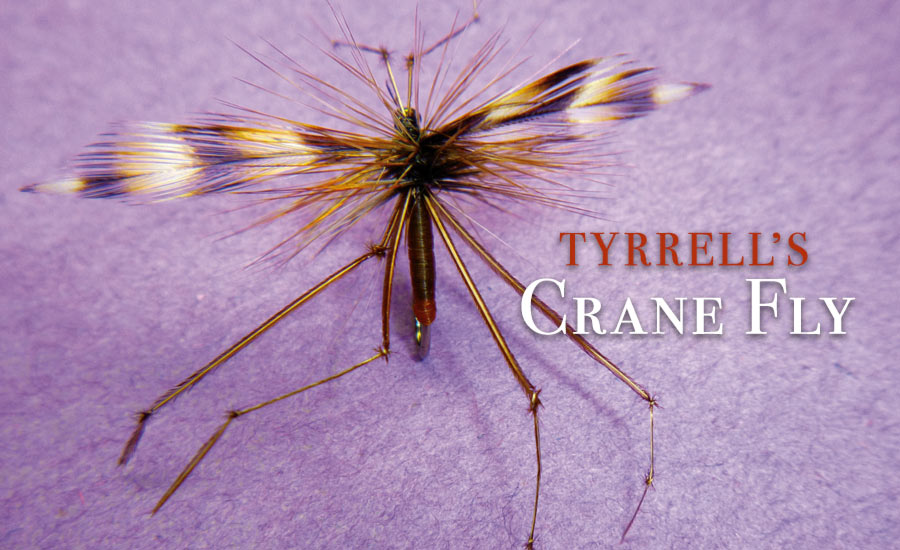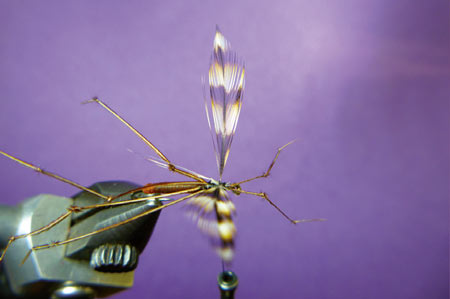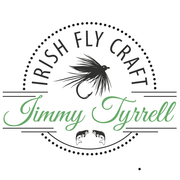Tyrrell's Crane Fly - Irish Angler Magazine August 2010
- by James Tyrrell
-

What can be said about this pattern only that it is a fly that almost every angler has heard of and used at some stage? Jimmy Tyrrell tells you how to tie his version of the Daddy.
Crane flies are more commonly known as ‘Daddies’ or ‘Harries’ and are of great interest to anglers during late summer. This is a great pattern to use from late July through to September. It can be used not only for brown trout and rainbows but also for sea trout and salmon on the loughs. If you have ever had the experience of seeing these flies get blown onto the river or lough and then seen them disappear very quickly after being taken by fish it becomes clear why the trout like them. The natural comes in a variety of sizes, but it is the larger ones that are of most interest to the angler. It’s a big fly and a bonus for any feeding trout in the vicinity of any Daddies getting blown onto the water.
The larva is of no interest to the fly angler as it is a land-bred insect. It’s only when it transforms into the adult which sometimes gets carried on to the water on a breeze that it becomes food for the trout. That’s why the natural insect was traditionally used for dapping on the loughs. It’s a fly that will often tempt a nice trout to the surface when there is no other fly life around. They get blown onto the surface of the water and when they start to struggle in the surface film will often catch the attention of a good trout. So it pays to twitch the fly line to give the fly a bit of life, creating small ripples in the water.
On the river, this is a great fly to put up on those balmy summer days when there’s nothing happening and the water levels are low. Cast into a nice pool it will sometimes bring a decent fish to the surface.
"This is a great pattern to use from late July through to September. It can be used not only for brown trout and rainbows but also for sea trout and salmon on the loughs."
Daddies can be fished wet or dry, dry being the most popular method. Although the dry pattern is probably the most common style I do occasionally get people asking me to tie the wet Daddies. I like to tie my daddies in as lifelike a manner as possible and don’t like to overdress them with too much hackle, just enough to make the fly float on the water. It is not really a difficult fly to imitate and most imitations will take fish, I don’t even think it’s that necessary to add wings as they tend to get broken off after a bit of use, but I like to add them as I think it gives the fly more of a realistic appearance.
Daddies are tied with a vast array of different materials, but floss and raffia are probably the most common. Raffia is probably used more frequently than any other. You can get this material in lots of different shades, but I often use a waterproof marker to colour the body if I haven’t got the one I want. And then there are people who have there own favourite patterns and colours. The Silver Daddy is very popular pattern when fished wet using a softer hackle at the head and the wings sloping back over the body. This is used to imitate a drowned daddy long legs and also catches its share of fish.
One of my favourite patterns is the Spanflex Daddy. This material is the same as an elastic band and gives a nice segmented body to the fly. You can even use an elastic band if you can’t find Spanflex. I have tied up a this pattern using Spanflex for the body. It comes in a large range of colours and widths and can be used to tie a lot of other patterns.
It’s a relatively easy pattern to tie. The hardest part is probably knotting the legs. You can buy various tools to do this, or you can even buy the legs pre-knotted and in a huge variety of different colours, but I prefer the natural colour for this pattern. I find knotting them by hand is easier with practice. Sometimes I sit watching the television tying up the legs and it’s surprising how many you can do in a couple of hours.
Tyrrell's Crane Fly
| Hook: | Size 10 Kamasan B170 |
| Tying Silk: | Danvilles |
| Body: | Spanflex |
| Legs: | Cock Pheasant Centre Tail |
| Wings: | Cree Hackle Tips |
| Hackle: | Cree Cock |
Tying Instructions
 Step One: Wind on the tying silk to form an even base for the body.
Step One: Wind on the tying silk to form an even base for the body. Step Two: Tie in the length of Spanflex at the rear.
Step Two: Tie in the length of Spanflex at the rear. Step Three: Apply some vanish to the tying silk.
Step Three: Apply some vanish to the tying silk. Step Four: Wind the Spanflex up the hook shank in touching turns,
stopping about a third of the way.
Step Four: Wind the Spanflex up the hook shank in touching turns,
stopping about a third of the way. Step Five: Tie in a bunch of knotted legs and divide them.
Step Five: Tie in a bunch of knotted legs and divide them. Step Six: Select two nice well-marked Cree hackle tips for the
wings.
Step Six: Select two nice well-marked Cree hackle tips for the
wings. Step Seven: Tie in the hackle tips and divide them by going between
them with the tying thread.
Step Seven: Tie in the hackle tips and divide them by going between
them with the tying thread. Step Eight: Tie in head hackle.
Step Eight: Tie in head hackle. Step Nine: Wind on the hackle, tie off, whip finish and varnish the
head.
Step Nine: Wind on the hackle, tie off, whip finish and varnish the
head.Tying Tips
Tip 1: Use the centre
tail from a cock
pheasant as it
has the longest
fibres which are
a lot easier to
use when tying
up the legs.
TIP 2: Apply some
varnish to the
tying silk on
the hook shank
to secure the
Spanflex before
you start to form
the body.
TIP 3: Make sure to
keep the tying
thread flat with
no bumps
before winding
up the body.
TIP 4: Make a few
turns of the
Spanflex at the
start to create
a bump before
winding up the
shank.
TIP 5: Wind the
body on in
overlapping
turns to give
a segmented
effect.
TIP 6: Don’t over
hackle the fly –
four or five turns
is sufficient.





